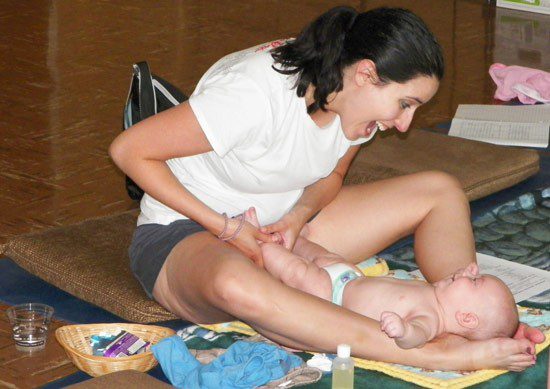Touch Relaxation is a part of our curriculum. It should be taught in every class, throughout the teaching of the strokes.
I developed Touch Relaxation after having experienced something similar in Lamaze childbirth education classes when I was pregnant, and subsequently reading thoroughly about “conditioned response,” which was developed by the behaviorists in psychology. You may have heard of the experiments with dogs. A short version of the experiment: A group of dogs were given food after hearing a certain sound. After repeating this several times, the sound was made without giving the dogs food. The dogs began salivating upon hearing the sound.
How does this relate to infant massage? In my Lamaze childbirth preparation class, our partners would gently touch, shake, bounce and pat an area of our body — perhaps an arm — and quietly say, “relax.” We consciously relaxed that area. This was done over and over again, with different parts of the body. After a few weeks of this practice, our partners would gently touch an area, quietly say “relax,” and we would find that the area automatically relaxed. This was very helpful during labor, when someone just saying “Relax!” wouldn’t work. Touch relaxation creates “muscle memory.”
When I began massaging my first baby and developing our curriculum, I decided to incorporate this “conditioned response” into the massage. Before starting the strokes — say, on the leg — I would gently touch, shake, bounce and pat the leg and say, “Reee-laaaax” in a high-pitched, sing-song way. I knew that babies respond well to that kind of speech, often called “parentese.”
I wrote about Touch Relaxation in my book, so if it was not emphasized in your training, I recommend you read about it, point it out to the parents (and where they can find it in my book) and incorporate it into your instruction. Babies learn to relax in response to the touch and the sound of a parent saying “relax” in this way. Like other parts of the massage, Touch Relaxation takes repetition to work its magic. When it is done properly, the baby’s body has a “muscle memory” that makes them relax an area when a parent touches that area. The memory stays with them, and parents can continue to use this as their child grows.
I found Touch Relaxation very useful as my children grew. When they were stressed in some way, I would use Touch Relaxation to help them calm. For example, when my daughter was having teeth removed, I sat beside her while the dentist worked, and used Touch Relaxation. I would gently touch, shake, and pat her leg, and say “Reee-laaax,” and her body would automatically cooperate. I was creative in using it: she had a kitten named Blackie, so I used that to help her visualize in a way that would relax her. I said, “Whenever I touch you, imagine Blackie is rubbing against you, and relax.” As I touched, shook, and patted her leg, I would say “Here comes Blackie. . . .” and her leg would automatically relax. This not only helped her stay relaxed during this stressful experience, but kept her mind busy with the ideation of her kitty rubbing up against her. As a result, the dentist asked me to give a seminar for his patients’ parents about how to do this.
As you are teaching, start each area with Touch Relaxation. Explain to parents what it is and why they should do it. Observe everyone closely, giving praise and pointing out when you see the magic of Touch Relaxation working. You can use it as a discussion point in the third or fourth class, asking parents if they had tried it and what result they got.
So, to sum up:
- After the parent has prepared, is relaxed and ready, has requested permission:
- The parent gently holds the leg (“Resting Hands”).
- The parent gently bounces the leg, saying “reee-laaax.”
- When the baby’s leg relaxes, the parent gives positive feedback: smile, “Great! You relaxed your leg!”
- Begin the strokes for the leg.
Touch Relaxation is very useful during the massage. After the baby learns to relax in response to her parent’s touch and voice, each stroke is begun with a relaxed (leg, arm, tummy, etc.), which makes the massage strokes even more effective. I recommend that you take notes, observing for yourself how this simple practice works. As you see results, your enthusiasm for it will grow.





